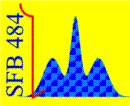
Third International Workshop 2008
Ordering Phenomena in Transition Metal Oxides
October 5 - 8, 2008, Augsburg, Germany
|
Welcome Conference Venue Accommodation Group Photo Invited Speakers (with Abstracts) Program Poster Session Technical Information Organization Travel Information Weather SFB 484 Institute of Physics |
|
Invited Talk
|
|
| Claudia Felser (Mainz) | |
|
Heusler compounds: Correlated materials?
|
|
|
Many open shell systems were predicted to be half metallic ferromagnets such as Heusler compounds [1] or Rb4O6 [2]. The mixed-valent open shell 2p-system Rb4O6 was predicted to be a half-metallic ferromagnet at room temperature. However, experiments show that Rb4O6 exhibits the time dependent magnetic behaviour of a frustrated antiferromagnet [3]. The discrepancy is corrected by incorporating correlations in the oxygen p-electrons in the calculations for this highly localised open shell system [4]. A compound with a partially occupied band with a small band width can become easily ferromagnetic and half metallic. Here we raise the question of whether it is necessary to include correlations also for the description of Heusler compounds. The development of magnetic Heusler compounds specifically designed as materials for spintronic applications has made tremendous progress in the very recent past [5]. Half-metallic ferromagnetism was first discussed for the C1b compound NiMnSb [1]. Half metallic ferromagnets behave like metals with respect to the electrons of one spin direction and like semiconductors with respect to the electrons of the other spin direction. C1b compounds of composition XYZ (X=metal, mostly transition or rare earth metals; Y=transition metals, Z=main-group element) consist of three interpenetrating fcc lattices. From the viewpoint of electronic structures, the most appropriate description of these compounds is as a zinc-blende YZ lattice stuffed with X atoms. The compounds can be thought of as comprising Xn+ ions stuffed in a zinc-blende-type [YZ]n- sublattice, where the number of valence electrons associated with the [YZ]n- sublattice is 8 or 18 (d10+s2+p6) [6]. Most of the magnetic and half-metallic C1b compounds contain manganese or a rare earth. This is not accidental because, as described by Kübler et al.[7] the properties of the manganese ions in the Y position of the Heusler compounds must be taken into account. These manganese ions, which have an approximate Mn3+ configuration, have a highly localized moment that ranges from 3-4mB. The rare-earth ions (RE) in C1b compounds (for example, RENiSb or REAuSn) also exhibit a charge of +3 and a magnetic moment corresponding to localized f states [6]. Heusler compounds have the chemical formula X2YZ (X, Y=transition metals, Z=main-group element) [8]. Ordered Heusler compounds crystallize in the L21 structure. The additional X atom fills the remaining tetrahedral vacancy in the C1b (XYZ) structure and renders a second magnetic sublattice possible. Despite lot of efforts in theory and experiment to describe bulk materials and thin films, there are some marked discrepancies between observed and predicted properties of these materials. These discrepancies appear not only across but also within synthesis methods as well as in the theoretical predictions. The electronic structure of Co2YSi (Y, Sc, Ti; V, Cr, Mn, Fe) will be discussed, in particular, the magnetic moments and the minority band gaps in these materials will be examined respecting electron-electron correlation in the calculations [9]. The theoretical considerations are compared with our high energy photoemission results [10]. Ferrimagnetic Heusler compounds are candidates for spin torque application, because of the low magnetic moments. The high Curie temperatures make these Heusler promising materials for Spin torque applications. Mn3Ga with Heusler structure was predicted to be a half metallic compensated ferrimagnet [11]. However the synthesized material is tetragonal distorted, but still a suitable material for spin torque transfer applications. The material is hard magnetic and has a saturation magnetization in average about ¼ μB / at. The Curie temperature is above the decomposition temperature of about 730 K. The electronic structure calculation indicates a ground state with ferrimagnetic order and 88% spin polarization at the Fermi Energy [12,13]. Acknowledgments: This work was financially supported by the DFG as part of the FG 559, projects TP1 and TP7, as well as by the BMBF Projekt Heusprin. [1] R. A. de Groot, F. M. Müller, P. G. van Engen, K. H. J. Buschow, Phys. Rev. Lett. 50, 2024 (1983). [2] J. J. Attema, G. A. de Wijs, G. R. Blake, R. A. de Groot, J. Am. Chem. Soc. 127, 16325 (2005). [3] J. Winterlik, G. H. Fecher, C. Felser, C. Muhle, M. Jansen, J. Am. Chem. Soc. 129, 6990 (2007). [4] J. Winterlik, G. H. Fecher, C. A. Jenkins, C. Felser, C. Mühle, K. Doll, M. Jansen, L. M. Sandratskii and J. Kübler, submitted PRL [5] C. Felser, G. H. Fecher, B. Balke, Angew. Chem. (int. ed.) 46, 668 (2007). [6] H. C. Kandpal, C. Felser, R. Seshadri, J. Phys. D: Appl. Phys. 39 776 (2006). [7] J. Kübler, A. R.Williams, C. B. Sommers, Phys. Rev. B 28, 1745 (1983). [8] F. Heusler, Verh. Dtsch. Phys. Ges. 12 (1903) 219. [9] H. C. Kandpal, G. H. Fecher, C. Felser, G. Schonhense, Phys. Rev. B 73, 094422 (2006). [10] G. H. Fecher, B. Balke, S. Ouardi, C. Felser, G. Schonhense, E. Ikenaga, J. J. Kim, S. Ueda, K. Kobayashi. J. Phys. D.: Appl. Phys. 40, 1576 (2007). [11] S. Wurmehl, G. H. Fecher, H. C. Kandpal, and C. Felser J.Phys. Cond. Matter 18 (2006) 6171. [12] B. Balke, G. H. Fecher, J. Winterlik, C. Felser, Appl. Phys. Lett. 90, 152504 (2007) [13] J. Winterlik, B. Balke, Sabine Wurmehl, G. H. Fecher and C. Felser, M. C. Alves, J. Morais, G. Azevedo and F. Furlan, Phys. Rev. B 77, 054406 (2008). |
|
|
previous / next - Invited Speakers - Program |
|
| [ 21-Apr-17 ] | [ http://www.physik.uni-augsburg.de/sfb484/Augsburg2008/abstracts/felser.shtml ] |